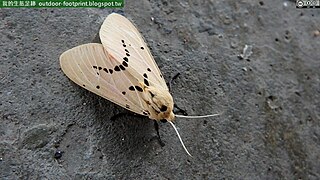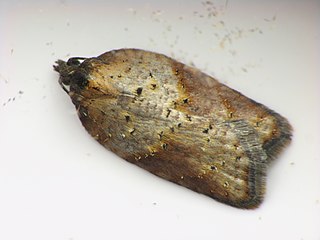
Lepidoptera is an order of insects that includes butterflies and moths. About 180,000 species of the Lepidoptera are described, in 126 families and 46 superfamilies, 10 per cent of the total described species of living organisms. It is one of the most widespread and widely recognizable insect orders in the world. The Lepidoptera show many variations of the basic body structure that have evolved to gain advantages in lifestyle and distribution. Recent estimates suggest the order may have more species than earlier thought, and is among the four most speciose orders, along with the Hymenoptera, Diptera, and Coleoptera.

The Arctiinae are a large and diverse subfamily of moths, with around 11,000 species found all over the world, including 6,000 neotropical species. This group includes the groups commonly known as tiger moths, which usually have bright colours, footmen, which are usually much drabber, lichen moths, and wasp moths. Many species have "hairy" caterpillars that are popularly known as woolly bears or woolly worms. The scientific name of this subfamily refers to this hairiness. Some species within the Arctiinae have the word tussock in their common name due to people misidentifying them as members of the Lymantriinae based on the characteristics of the larvae.

A proboscis is an elongated appendage from the head of an animal, either a vertebrate or an invertebrate. In invertebrates, the term usually refers to tubular mouthparts used for feeding and sucking. In vertebrates, a proboscis is an elongated nose or snout.

Oenosandridae is a family of Australian noctuoid moths. Genera include:

Yponomeutoidea is a superfamily of ermine moths and relatives.

The Arctiini are a tribe of tiger moths in the family Erebidae.

The Adelidae or fairy longhorn moths are a family of monotrysian moths in the lepidopteran infraorder Heteroneura. The family was first described by Charles Théophile Bruand d'Uzelle in 1851. Most species have at least partially metallic patterns coloration and are diurnal, sometimes swarming around the tips of branches with an undulating flight. Others are crepuscular and have a drab coloration. Fairy longhorn moths have a wingspan of 4–28 millimeters, and males often have especially long antennae, 1–3 times as long as the forewing.

The Archipini are a tribe of tortrix moths. Since many genera of these are not yet assigned to tribes, the genus list presented here is provisional.
Cimeliidae, the gold moths, is a family of moths that is now placed in the macroheteroceran superfamily Drepanoidea, although previously placed in its own superfamily. Uniquely, they have a pair of pocket-like organs on the seventh abdominal spiracle of the adult moth which are only possibly sound receptive organs. They are quite large and brightly coloured moths that occur in southern Europe and feed on species of Euphorbia. Sometimes they are attracted to light. The family was first described by Pierre Chrétien in 1916.

The Cochylini are a tribe of tortrix moths. It used to be classified as the subfamily Cochylinae.

Spilarctia is a genus of moths in the family Erebidae. The genus was erected by Arthur Gardiner Butler in 1875.
The Obtectomera is a clade of macro-moths and butterflies, comprising over 100,000 species in at least 12 superfamilies.

Sterrhinae is a large subfamily of geometer moths with some 3,000 described species, with more than half belonging to the taxonomically difficult, very diverse genera, Idaea and Scopula. This subfamily was described by Edward Meyrick in 1892. They are the most diverse in the tropics with the number of species decreasing with increasing latitude and elevation.

The Euliini are a tribe of tortrix moths.

The Tortricini are a tribe of tortrix moths.

The Nyctemerina are a subtribe of woolly bear moths in the family Erebidae.
Alexey Diakonoff full name Alexey Nikolaievich Diakonoff was a Russian entomologist who specialised in Microlepidoptera.

Gracillariinae are a subfamily of moths which was described by Henry Tibbats Stainton in 1854.

The Zeuzerinae are a subfamily of the family Cossidae.
The Macroheterocera are well supported clade of moths that are closely related to butterflies and other macro-moths.















